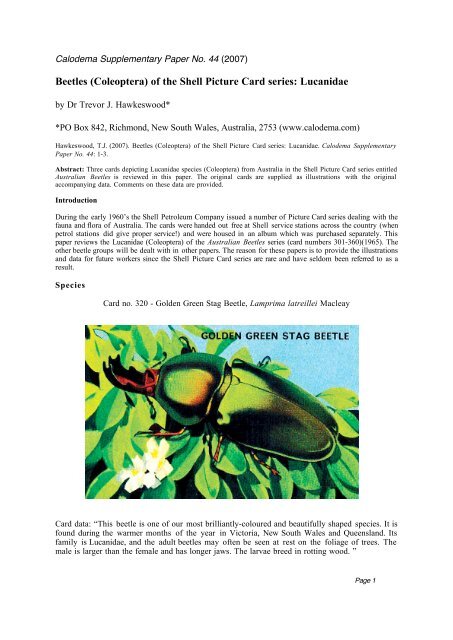Beetles (Coleoptera) of the Shell Picture Card series ... - Calodema
Beetles (Coleoptera) of the Shell Picture Card series ... - Calodema
Beetles (Coleoptera) of the Shell Picture Card series ... - Calodema
Create successful ePaper yourself
Turn your PDF publications into a flip-book with our unique Google optimized e-Paper software.
<strong>Calodema</strong> Supplementary Paper No. 44 (2007)<br />
<strong>Beetles</strong> (<strong>Coleoptera</strong>) <strong>of</strong> <strong>the</strong> <strong>Shell</strong> <strong>Picture</strong> <strong>Card</strong> <strong>series</strong>: Lucanidae<br />
by Dr Trevor J. Hawkeswood*<br />
*PO Box 842, Richmond, New South Wales, Australia, 2753 (www.calodema.com)<br />
Hawkeswood, T.J. (2007). <strong>Beetles</strong> (<strong>Coleoptera</strong>) <strong>of</strong> <strong>the</strong> <strong>Shell</strong> <strong>Picture</strong> <strong>Card</strong> <strong>series</strong>: Lucanidae. <strong>Calodema</strong> Supplementary<br />
Paper No. 44: 1-3.<br />
Abstract: Three cards depicting Lucanidae species (<strong>Coleoptera</strong>) from Australia in <strong>the</strong> <strong>Shell</strong> <strong>Picture</strong> <strong>Card</strong> <strong>series</strong> entitled<br />
Australian <strong>Beetles</strong> is reviewed in this paper. The original cards are supplied as illustrations with <strong>the</strong> original<br />
accompanying data. Comments on <strong>the</strong>se data are provided.<br />
Introduction<br />
During <strong>the</strong> early 1960’s <strong>the</strong> <strong>Shell</strong> Petroleum Company issued a number <strong>of</strong> <strong>Picture</strong> <strong>Card</strong> <strong>series</strong> dealing with <strong>the</strong><br />
fauna and flora <strong>of</strong> Australia. The cards were handed out free at <strong>Shell</strong> service stations across <strong>the</strong> country (when<br />
petrol stations did give proper service!) and were housed in an album which was purchased separately. This<br />
paper reviews <strong>the</strong> Lucanidae (<strong>Coleoptera</strong>) <strong>of</strong> <strong>the</strong> Australian <strong>Beetles</strong> <strong>series</strong> (card numbers 301-360)(1965). The<br />
o<strong>the</strong>r beetle groups will be dealt with in o<strong>the</strong>r papers. The reason for <strong>the</strong>se papers is to provide <strong>the</strong> illustrations<br />
and data for future workers since <strong>the</strong> <strong>Shell</strong> <strong>Picture</strong> <strong>Card</strong> <strong>series</strong> are rare and have seldom been referred to as a<br />
result.<br />
Species<br />
<strong>Card</strong> no. 320 - Golden Green Stag Beetle, Lamprima latreillei Macleay<br />
<strong>Card</strong> data: “This beetle is one <strong>of</strong> our most brilliantly-coloured and beautifully shaped species. It is<br />
found during <strong>the</strong> warmer months <strong>of</strong> <strong>the</strong> year in Victoria, New South Wales and Queensland. Its<br />
family is Lucanidae, and <strong>the</strong> adult beetles may <strong>of</strong>ten be seen at rest on <strong>the</strong> foliage <strong>of</strong> trees. The<br />
male is larger than <strong>the</strong> female and has longer jaws. The larvae breed in rotting wood. ”<br />
Page 1
<strong>Calodema</strong> Supplementary Paper No. 44 (2007)<br />
Comments: Nothing appears to have been written on <strong>the</strong> biology <strong>of</strong> this species since publication<br />
<strong>of</strong> <strong>the</strong> <strong>Shell</strong> <strong>Picture</strong> <strong>Card</strong> <strong>series</strong>. Earlier, Froggatt (1915) recorded notes on <strong>the</strong> biology <strong>of</strong> <strong>the</strong><br />
beetle, which occurs only in New South Wales and Victoria. The related species, Lamprima<br />
aurata Latreille, occurs in Queensland (Hawkeswood, 1987).<br />
<strong>Card</strong> no. 333 - Resplendent Stag Beetle, Phalacrognathus muelleri Macleay<br />
<strong>Card</strong> data: “This is certainly one <strong>of</strong> <strong>the</strong> rarest and most beautiful <strong>of</strong> Australian beetles. The males<br />
are larger and have much bigger jaws than <strong>the</strong> females. Stag beetles inhabit <strong>the</strong> rain forests <strong>of</strong><br />
Nor<strong>the</strong>rn Queensland, where <strong>the</strong>ir larvae are generally found boring into rotting logs <strong>of</strong> <strong>the</strong> red<br />
cedar. This beetle belongs to <strong>the</strong> family Lucanidae. ”<br />
Comments: This species is very well known and sought after by insect collectors and unscrupulous<br />
traders (see Hawkeswood et al., 1991). Hawkeswood (1987) reviewed <strong>the</strong> biology <strong>of</strong> <strong>the</strong> species.<br />
Earlier, Brunet (1981) provided biological notes on <strong>the</strong> species, while later, Wood et al. (1996)<br />
provided fur<strong>the</strong>r biological data and a summary <strong>of</strong> most <strong>of</strong> <strong>the</strong> published data on <strong>the</strong> species to<br />
that date. The species is restricted to <strong>the</strong> rainforests <strong>of</strong> north Queensland. “red cedar” mentioned<br />
in <strong>the</strong> Shall <strong>Picture</strong> <strong>Card</strong> data above, is Toona (Cedrela) australis (Meliaceae).<br />
<strong>Card</strong> no. 359 - Barrington Stag Beetle, Lissapterus tetrops Lea<br />
<strong>Card</strong> data: “Flightless stag beetles (family Lucanidae) frequent <strong>the</strong> wet, mountain-forest regions<br />
<strong>of</strong> Tasmania and <strong>the</strong> mainland Great Dividing Range. This species is found at Barrington Tops<br />
plateau, Mount Royal Range, New South Wales. The male (illustrated) has long, pincer-like jaws<br />
but is unable to bite; <strong>the</strong> female, with much shorter jaws, can inflict a painful nip. Adult beetles<br />
are found under fallen logs in which <strong>the</strong> larvae feed. ”<br />
Comments: This species is poorly known and nothing appears to have been written on it since<br />
<strong>the</strong> <strong>Shell</strong> <strong>Picture</strong> <strong>Card</strong> <strong>series</strong>.<br />
Page 2
<strong>Calodema</strong> Supplementary Paper No. 44 (2007)<br />
References<br />
Brunet, B.L. (1981). Some observations on <strong>the</strong> North Queensland stag beetle. North Queensland Naturalist,<br />
45: 12-13.<br />
Froggatt, W.W. (1915). Notes and exhibits. Note on <strong>the</strong> life-history <strong>of</strong> Lamprima latreillei. Proceedings <strong>of</strong> <strong>the</strong><br />
Linnean Society <strong>of</strong> New South Wales, 40: 210.<br />
Hawkeswood, T.J. (1987). <strong>Beetles</strong> <strong>of</strong> Australia. Angus & Robertson Publishers, Sydney.<br />
Hawkeswood, T.J., Callister, D.J. & Antram, F. (1991). Collection and export <strong>of</strong> Australian Insects: An<br />
analysis <strong>of</strong> legislative protection and trade to Europe. Traffic Bulletin, 12: 41-48.<br />
Wood, G.A., Hasenpusch, J. & Storey, R.I. (1996). The life history <strong>of</strong> Phalacrognathus muelleri (Macleay)<br />
(<strong>Coleoptera</strong>: Lucanidae). Australian Entomologist, 23: 37-48.<br />
Page 3

















